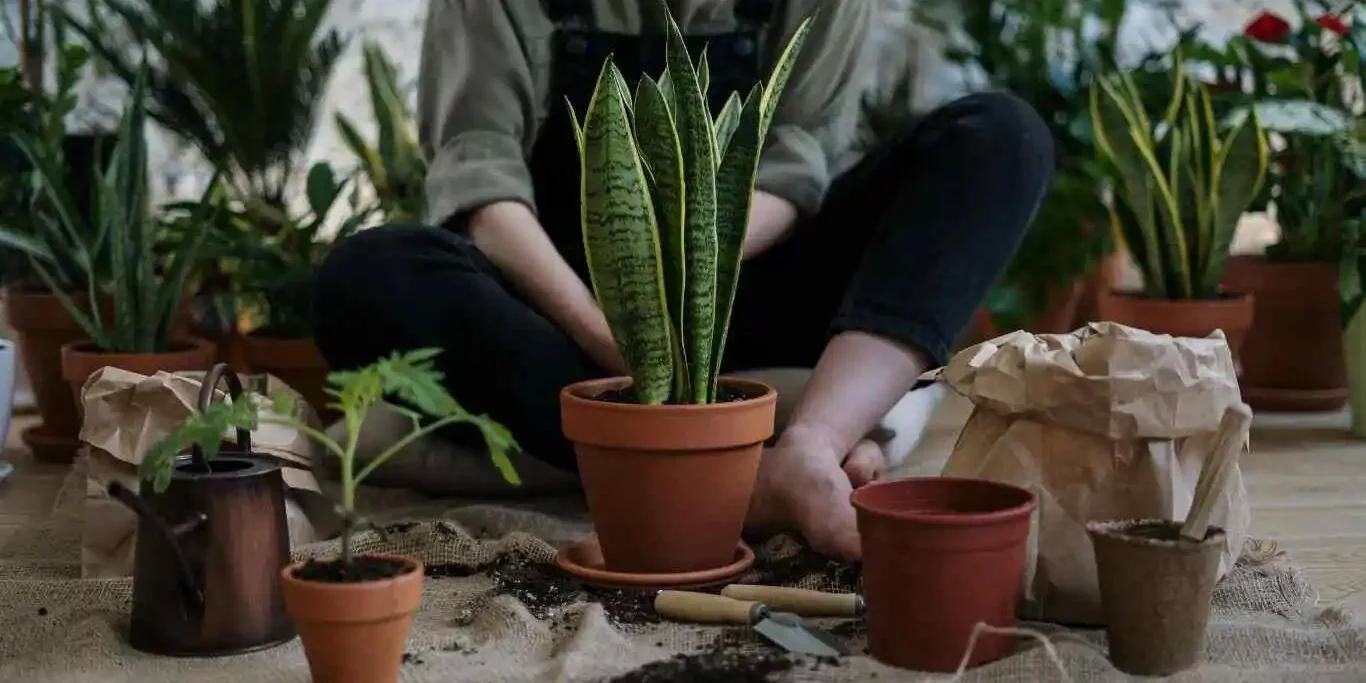Snake plants are one of the world’s prettiest and most beneficial houseplants. It has strong, upright leaves. It is also one of the most low-maintenance houseplants and is perfect for beginners and seasoned plant lovers. But here’s the catch—”low-maintenance” doesn’t mean “no-maintenance.” Proper snake plant care is essential, as many people bring home a snake plant assuming it will survive on pure neglect, only to find yellowing leaves, soggy soil, or stunted growth.
Snake plants are hardy, but still need some care to look their best. Understanding proper snake plant care is key, whether you’re trying to brighten up your living room, improve indoor air quality, or enjoy a plant that won’t demand constant attention. The good news is that you can keep your snake plant happy for years with just a few simple steps. This guide will provide all kinds of information you need, from watering and light to soil, repotting, and troubleshooting common problems.
Why Snake Plants Make Great Houseplants
Snake plants are one of the world’s most fashionable and popular houseplants. They’re well known for:
- Toughness: These hardy plants can survive in dry conditions and low light.
- Air-purifying qualities: NASA‘s famous Clean Air Study showed that snake plants can filter toxins like Benzene, Formaldehyde, Xylene, and Trichloroethylene.
- Unique style: Their strong, tall, sword-shaped upright leaves add instant structure and greenery to any room.
This combination of beauty and resilience makes them the most popular indoor plants.
Light Requirements for Snake Plants
Snake plants are very versatile. They will develop in:
- Bright, indirect sunlight: Their favorite spot. Filtered light near a window works perfectly.
- Low-light conditions: They’ll survive, but growth may slow down. Excellent for offices or bedrooms
- Direct sunlight: Morning or evening sunlight is fine, but strong midday sunlight can scorch the leaves.
👉 Pro Tip: To ensure your plant grows uniformly and doesn’t tilt toward the light source, rotate it every few weeks.
Watering Your Snake Plant the Right Way
The leading cause of snake plant death is overwatering. They don’t require frequent watering because their thick, fleshy leaves retain water.
- Spring and summer (active growing season): Water every two to three weeks, letting the soil dry out completely in between.
- Fall and winter (dormant period): Low to once a month or less.
Signs of overwatering: mushy leaves, root rot, or a foul smell from the soil.
Signs of underwatering: wrinkled or curling leaves.
👉 Pro Tip: Water should be given at the base of the plant; don’t water the leaves to prevent rot.
The Best Soil for Snake Plants
Well-drained soil is best for snake plants. Heavy soil holds too much moisture, which leads to root rot. The best options are as follows:
- Cactus or succulent potting mix
- A blend of regular potting soil + sand or perlite
👉 Pro Tip: Make sure your pot has drainage holes—never let water sit at the bottom.
Temperature and Humidity
Although snake plants grow well indoors, they prefer the following conditions:
- Temperature: Snake plants grow well in 15–29°C (60–85°F). Avoid cold temperatures below 10°C (50°F).
- Humidity: The average room humidity is acceptable. Snake plants can tolerate drought. So, no need for misting.
Fertilizing Snake Plants
Snake plants require less fertilizer than other plants to thrive.
- When to fertilize: Once a month in the spring and summer.
- What to use: A half-strength solution of a balanced, all-purpose houseplant fertilizer.
- When to skip: Fall and winter. Plants naturally slow down growth during these months.
Repotting Your Snake Plant
Snake plants like being slightly root-bound, so they don’t need frequent repotting. However, repot when:
- Roots are forcing through the drainage holes
- The plant becomes top-heavy and tips over
- Slow growth of the plant due to crowded roots
Steps to repot:
- Choose 1-2 inches larger diameter pot than the existing one.
- Use fresh, well-draining soil.
- Gently remove the plant and shake off excess soil.
- Place it in the new pot, fill with soil, and water lightly.
👉 Pro Tip: Repotting is also a great time to divide and propagate your snake plant.
How to Propagate Snake Plants
Propagation is a cost-free and straightforward method of growing new snake plants. You can do this in three ways:
- Leaf cuttings in soil: Cut a healthy leaf into 3–4 inch pieces, plant it in soil, and let it develop roots.
- Leaf cuttings in water: Place cuttings in a jar of water until roots appear, then transfer to soil.
- Division: When repotting, separate the root rhizomes into smaller sections and plant them individually.
Common Snake Plant Problems and Solutions
Even with their hardiness, snake plants can face some problems. Solutions to those problems are as follows:
- Yellow leaves: Usually caused by overwatering. Avoid overwatering. Let the soil dry completely.
- Brown tips: Low humidity, too much fertilizer, or underwatering. Trim tips with sharp and clean scissors.
- Soft, mushy leaves: Root rot from excess water. Remove damaged parts and repot in dry soil. Avoid overwatering also.
- Pests (mealybugs, spider mites): Wipe leaves/branches with a damp cloth or use neem oil/insecticidal soap.
Styling and Placement Ideas for Snake Plants
Snake plants fit almost any décor style—modern, minimalist, or cozy boho. Some creative placement ideas:
- Corners of the living room: Add vertical height.
- Bedrooms: Their oxygen-boosting qualities make them great for sleep.
- Bathrooms: They can tolerate low light levels and occasional humidity.
- Offices: Perfect for desks or conference rooms since they need little attention.
Conclusion
Snake plant care is not complicated. Using the proper care methods, you can have a flourishing snake plant that enhances the home’s aesthetics and health benefits. The most frequent and severe error is overwatering; therefore, when in doubt, let the soil dry out.
Snake plants are truly the definition of “effortless beauty.” If you’re a first-time plant owner looking to make a green environment indoors, you want to follow the appropriate snake plant care technique to get the best results.
👉 Want more plant care tips? Explore our other houseplant guides to keep your indoor garden thriving.
Frequently Asked Questions (FAQs) About Snake Plant Care
How do you take care of a home snake plant?
Snake plant care indoors is effortless. Place the plant in bright, indirect light. Use well-drained soil. Water only when the soil dries out completely. Avoid overwatering to prevent root rot.
Do snake plants need sunlight?
To grow, snake plants need light, but not direct sunlight. These plants grow best in bright, indirect sunlight but can develop in less light. It works great near a window where the light is filtered.
How often do you water your snake plants?
Watering depends on the season. In the spring and summer, water every two to three weeks after the soil dries. Water your plants once a month or even less in the fall and winter. Most people mess up their snake plants by giving them too much water.
Where in your home is the best spot for a snake plant?
Snake plants fit well almost anywhere. Popular spots include living room corners, bedrooms (they release oxygen at night), and bathrooms with low light and moderate humidity. Just make sure the place isn’t too cold or drafty.
When to repot a snake plant?
Repot your snake plant every 2–3 years or when you notice roots are forcing through the drainage holes, the plant is becoming top-heavy, or showing slowed growth. Snake plants like being slightly root-bound, so frequent repotting isn’t necessary.
What soil type helps snake plants thrive?
Snake plants thrive in well-draining soil. A potting mix designed for succulents or cacti works well. A blend of regular potting soil mixed with sand or perlite can be used.
Can I use cactus soil for snake plants?
Yes, you can. It’s best to use cactus soil because it drains fast and keeps water from sitting around the roots. This makes root rot less likely to happen, which is something snake plants often get.
What are the signs of overwatering snake plants?
The most common signs include yellowing leaves, mushy or soft leaves, foul-smelling soil, and root rot. If you notice these, stop watering and allow the soil to dry completely before the next watering.
Do snake plants like to be crowded?
Yes, snake plants don’t mind being a little root-bound. In fact, they often grow well in slightly crowded pots. However, it’s time to repot when roots break through the pot or growth slows significantly.









